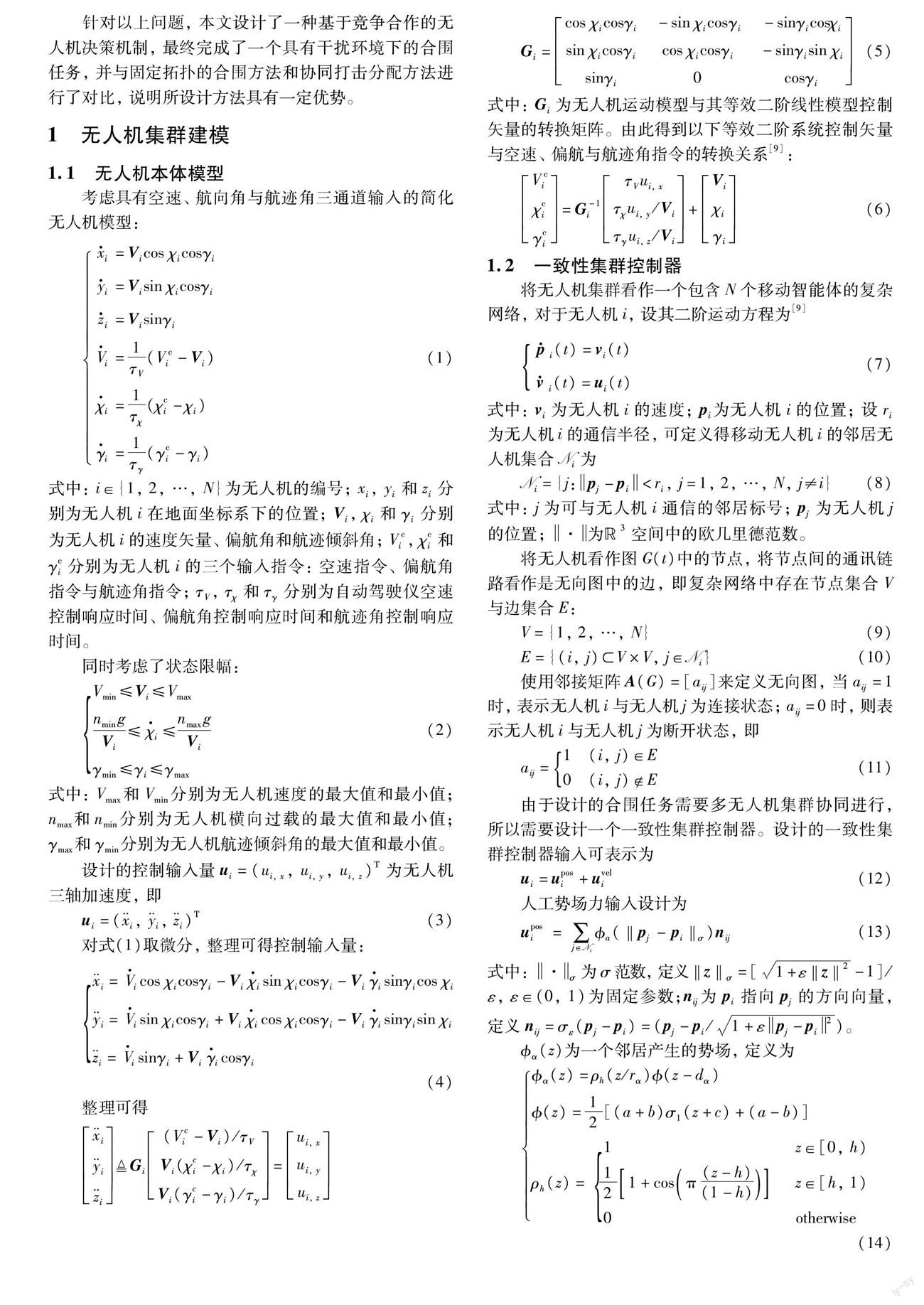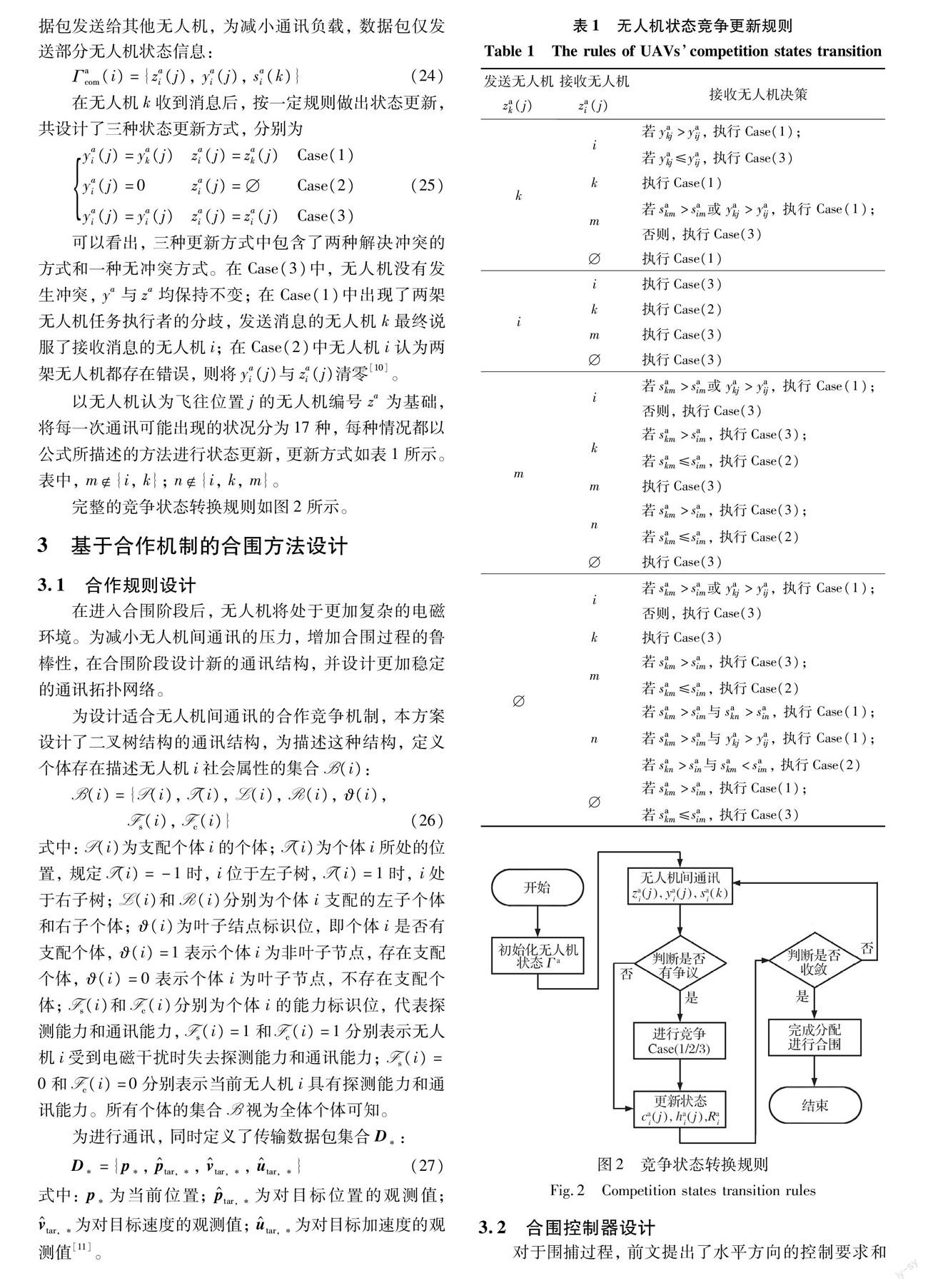基于竞争合作机制的无人机目标分配合围方法
2022-05-30宋泽昊刘冀川
宋泽昊 刘冀川



摘 要: 无人机合围已经成为现代战争的重要打击方式之一。近年来,无人机合围的控制算法得到了广泛的研究,提高了无人机合围形成编队的速度和无人机合围的鲁棒性。但这些算法没有考虑到传感器失效对无人机的影响,也没有考虑到合围初期的队形收敛速度。针对这些问题,本文提出了一种基于竞争合作机制的无人机目标分配合围方法。首先,对竞争机制进行分析,设计了基于竞争机制的无人机目标分配方法,提高了合围初期的队形收敛速度。其次,设计了基于合作机制的无人机合围方法,通过对合围过程中无人机的拓扑进行变换,保证在无人机出现探测失效或通讯失效时仍然可以获得目标的状态信息。仿真验证中,设计的方法可以在合围初期更快形成合围队形,且在发生通讯失效和探测失效时拥有更强的鲁棒性。
关键词: 无人机;集群;人工智能;竞争机制;合作机制;合围;目标分配
中图分类号: TJ765;V279
文献标识码:A
文章编号: 1673-5048(2022)05-0076-07
DOI: 10.12132/ISSN.1673-5048.2022.0055
0 引 言
近几年随着人工智能技术飞速发展,无人系统作战成为一种重要的作战方式[1]。对于空战部分,无人机(Unmannedaerial Vehicle,UAV)成为一种重要的作战兵种。无人机集群在进行动态任务分配时需要考虑不同的目标类型,针对性地指派适合类型的无人机执行任务。不仅如此,随着任务复杂度的不断提升,无人机集群飞行不再是单一任务序列的简单时序执行过程,任务环境的不确定性要求无人机集群可以及时对执行范围内的突发情况做出响应[2]。
无人机协同合围是一种重要的无人机打击方式,无人机可以进行大量投放,在高威胁环境中执行侦察任务。由于单个无人机的打击能力较弱,在侦察到敌对目标后,需要多无人机进行协同打击,无人机协同合围即为协同打击的重要一步[3]。由于战场环境往往比较复杂,所以对无人机的智能性和自主性有较高的要求[3];战场上激烈的电子战对合围控制器有较高的鲁棒性要求;合围目标的非合作性对合围的收敛有较高的快速性要求。
无人机协同合围的研究已经取得了显著成果。Vaughan等[4]最早通过观察生物的合作与竞争机制来进行合围研究,并且最终通过机器人模仿出了合围行为。Pierson等[5]考虑了多个防御者合围单个攻击者的问题,假设其具有单积分器动力学模型,使用矢量场的方法使合围者在合围过程中避碰和避障,最终形成编队将攻击者引导到安全区域,并将其扩展到基于双积分器动力学模型对群体攻击者的合围控制问题。Licitra等[6]考虑单个合围智能体对多个目标的合围问题,使用一种切换系统的方法,合围者通过在目标之间切换,以满足某些停留时间条件,保证最终轨迹的稳定性。
国内外学者对无人机任务分配的研究也取得了很多成果。梁国强等[7]建立了WASD任務分配模型,解决了广域搜索下的任务分配问题,并使用分层方法解决了大规模任务分配问题。曹雷等[8]通过使用拍卖算法在子群内进行协商,提出混合任务分配方法。可以看出,对合围与任务分配的研究已经取得了很多成果,对目标的机动情况和不同收益已经有了比较完备的理论,但对于环境的考虑仍然较少。
针对以上问题,本文设计了一种基于竞争合作的无人机决策机制,最终完成了一个具有干扰环境下的合围任务,并与固定拓扑的合围方法和协同打击分配方法进行了对比,说明所设计方法具有一定优势。
两种方法在目标转弯过程的对比如图5所示。两种方法在目标进行转弯时均表现出优异的性能。本文方法在尺度指数上占据微弱优势。
探测失效过程对比如图6所示。在此期间,本文使用的方法较对比方法有巨大优势。在切换拓扑的过程中,本文方法的序参量小于对比方法。但是在完成拓扑切换后,本方案的序参量在没有震荡的情况下完成再次收敛,尺度指数在较小的超调下完成收敛。对比方法两个指标都没有完成收敛。
通讯失效过程对比如图7所示。在应对通讯失效的过程中,本文方法没有显现出巨大的优势,但是本文方法的序参量最终完成了收敛,而对比方法存在一定的静态误差。
5 结 论
在现代空战的背景下,通过对竞争合作的机制分析,分别建立了基于竞争机制的合围位置分配和基于合作机制的合作合围通讯方式,最终完成了一个合围仿真实验,并与另一种方法进行对比。在初始分配、 探测失效和通讯失效三种过程中,提出的方法具有一定的性能优势。通过对竞争过程的设计,加快了合围初期的收敛速度,通过对合作方式的设计,增强了合围过程的鲁棒性。
参考文献:
[1] 卢志刚, 张岳, 王虎跃, 等. 地面无人系统编组作战的指挥与控制智能化[J]. 指挥与控制学报, 2021, 7(4): 350-358.
Lu Zhigang, Zhang Yue, Wang Huyue, et al. Intelligence of Command and Control in Formation Operation of Unmanned Ground Systems[J]. Journal of Command and Control, 2021, 7(4): 350-358.(in Chinese)
[2] Davis D T, Chung T H, Clement M R, et al. Consensus-Based Data Sharing for Large-Scale Aerial Swarm Coordination in Lossy Communications Environments[C]∥IEEE/RSJ International Conference on Intelligent Robots and Systems (IROS), 2016: 3801-3808.
[3] 胡乔林, 焦士俊, 刘剑豪, 等. 反美军无人机蜂群作战问题研究[J]. 飞航导弹, 2021(12): 88-92.
Hu Qiaolin, Jiao Shijun, Liu Jianhao, et al. Research on Anti US Drone Swarm Warfare[J]. Aerodynamic Missile Journal, 2021(12): 88-92.(in Chinese)
[4] Vaughan R, Sumpter N, Henderson J, et al. Experiments in Automatic Flock Control[J]. Robotics and Autonomous Systems, 2000, 31(1/2): 109-117.
[5] Pierson A, Schwager M. Controlling Noncooperative Herds with Robotic Herders[J]. IEEE Transactions on Robotics, 2018, 34(2): 517-525.
[6] Licitra R A, Bell Z I, Doucette E A, et al. Single Agent Indirect Herding of Multiple Targets: A Switched Adaptive Control Approach[J]. IEEE Control Systems Letters, 2018, 2(1): 127-132.
[7] 梁国强, 康宇航, 邢志川, 等. 基于离散粒子群优化的无人机协同多任务分配[J]. 计算机仿真, 2018, 35(2): 22-28.
Liang Guoqiang, Kang Yuhang, Xing Zhichuan, et al. UAV Coope-rative Multi-Task Assignment Based on Discrete Particle Swarm Optimization Algorithm[J]. Computer Simulation, 2018, 35(2): 22-28.(in Chinese)
[8] 曹雷, 譚何顺, 彭辉, 等. 一种多UAV混合动态任务分配方法[J]. 南京理工大学学报, 2015, 39(2): 206-214.
Cao Lei, Tan Heshun, Peng Hui, et al. Mixed Dynamic Task Allocation for Multiple UAV[J]. Journal of Nanjing University of Science and Technology, 2015, 39(2): 206-214.(in Chinese)
[9] Olfati-Saber R. Flocking for Multi-Agent Dynamic Systems: Algorithms and Theory[J]. IEEE Transactions on Automatic Control, 2006, 51(3): 401-420.
[10] Murakami H, Niizato T, Gunji Y P. Emergence of a Coherent and Cohesive Swarm Based on Mutual Anticipation[J]. Scientific Reports, 2017, 7: 46447.
[11] Dong X W, Li Y F, Lu C, et al. Time-Varying Formation Tracking for UAV Swarm Systems with Switching Directed Topologies[J]. IEEE Transactions on Neural Networks and Learning Systems, 2019, 30(12): 3674-3685.
[12] Han T, Chi M, Guan Z H, et al. Distributed Three-Dimensional Formation Containment Control of Multiple Unmanned Aerial Vehicle Systems[J]. Asian Journal of Control, 2017, 19(4): 1-11.
[13] 陈清阳, 辛宏博, 王玉杰, 等. 一种多机协同打击的快速航迹规划方法[J/OL]. 北京航空航天大学学报, 2022.https:∥www.cnki.com.cn/Article/CJFDTotal-BJHK20210514000.htm.
Chen Qingyang, Xin Hongbo, Wang Yujie, et al. A Rapid Path Planning Method for Multiple UAVs to Cooperative Strike[J/OL]. Journal of Beijing University of Aeronautics and Astronautics, 2022.https:∥www.cnki.com.cn/Article/CJFDTotal-BJHK20210514000.htm..(in Chinese)
Target Assignment and Multi-UAV Enclosing Method
Based on Competition and Cooperation Mechanism
Song Zehao1,Liu Jichuan2, 3*
(1. School of Automation Science and Electrical Engineering,Beihang University,Beijing 100183,China;
2. School of Electronic Engineering,Xidian University,Xian 710071,China;
3. Hebei Key Laboratory of Electromagnetic Spectrum Cognition and Control,
The 54th Research Institute of CETC,Shijiazhuang 050081,China)
Abstract: Multi-UAV enclosing has become one of the important attack methods in modern air combat. Recently, the algorithms of multi-UAV enclosing have been extensively studied to improve the formation speed of multi-UAV enclosing and improve the robustness. However, these algorithms fail to consider the impact of sensor failure on UAV, nor do consider the formation convergence speed at the initial stage of multi-UAV enclosing. Aiming at these problems, a method of multi-target assignment and multi-UAV enclosing based on competition and cooperation mechanism is proposed.Firstly, the competition mechanism is analysed, and the multi-target assignment method based on the competition mechanism is designed to improve the formation convergence speed.Secondly, a multi-UAV enclosing method is designed based on the cooperation mechanism.The method transforms the topology of the UAV to obtain the formation when the detection failure or communication failure happens. In the simulation, the designed method can form the enclosing formation faster, and has stronger robustness when the detection failure or communication failure happens.
Key words: UAV;cluster;artificial intelligence;competition mechanism;cooperation mechanism; enclosing;target assignment
收稿日期: 2022-03-20
作者簡介: 宋泽昊(1996-), 男, 黑龙江齐齐哈尔人, 硕士研究生。
通信作者: 刘冀川(1981-), 男, 河北保定人, 高级工程师。
